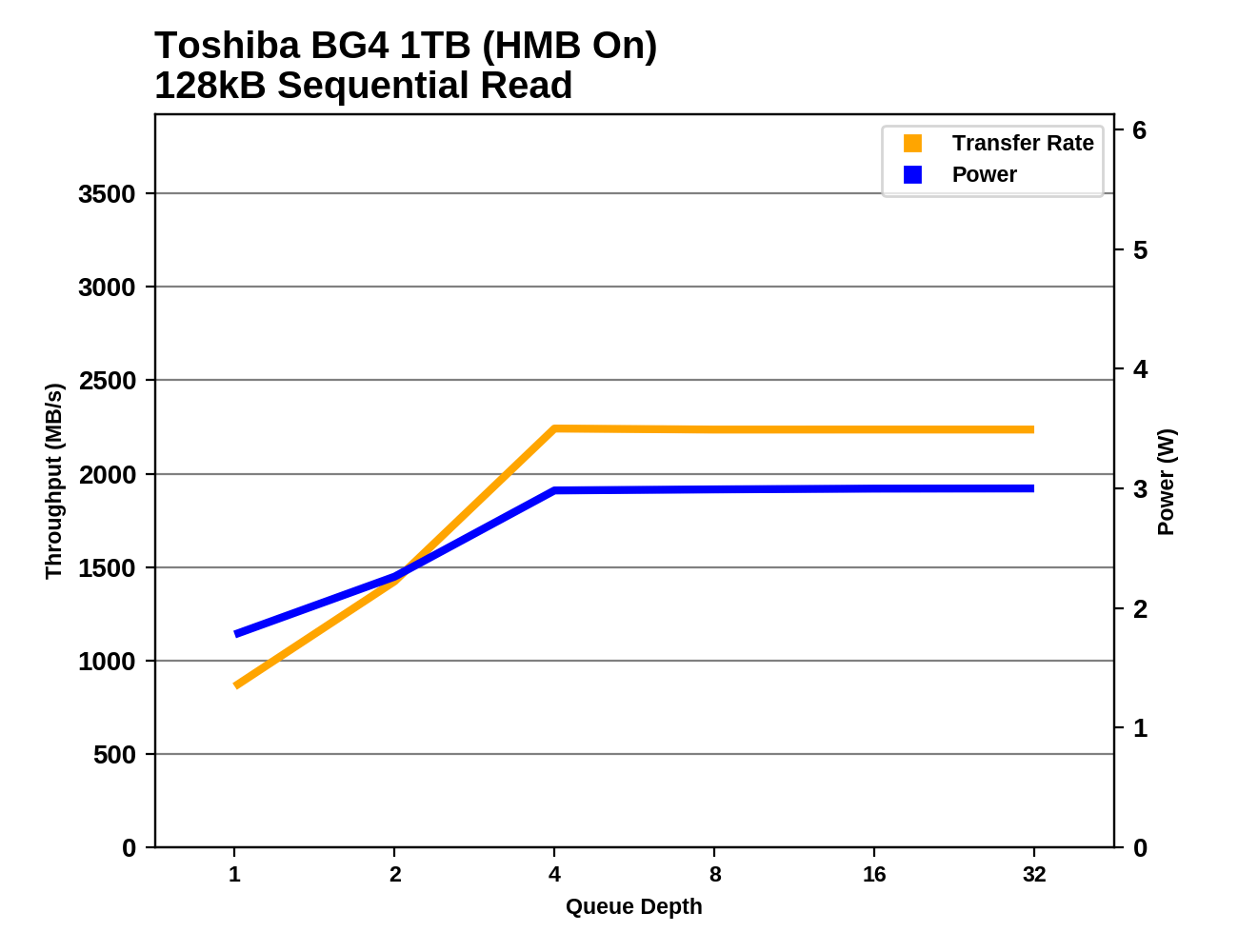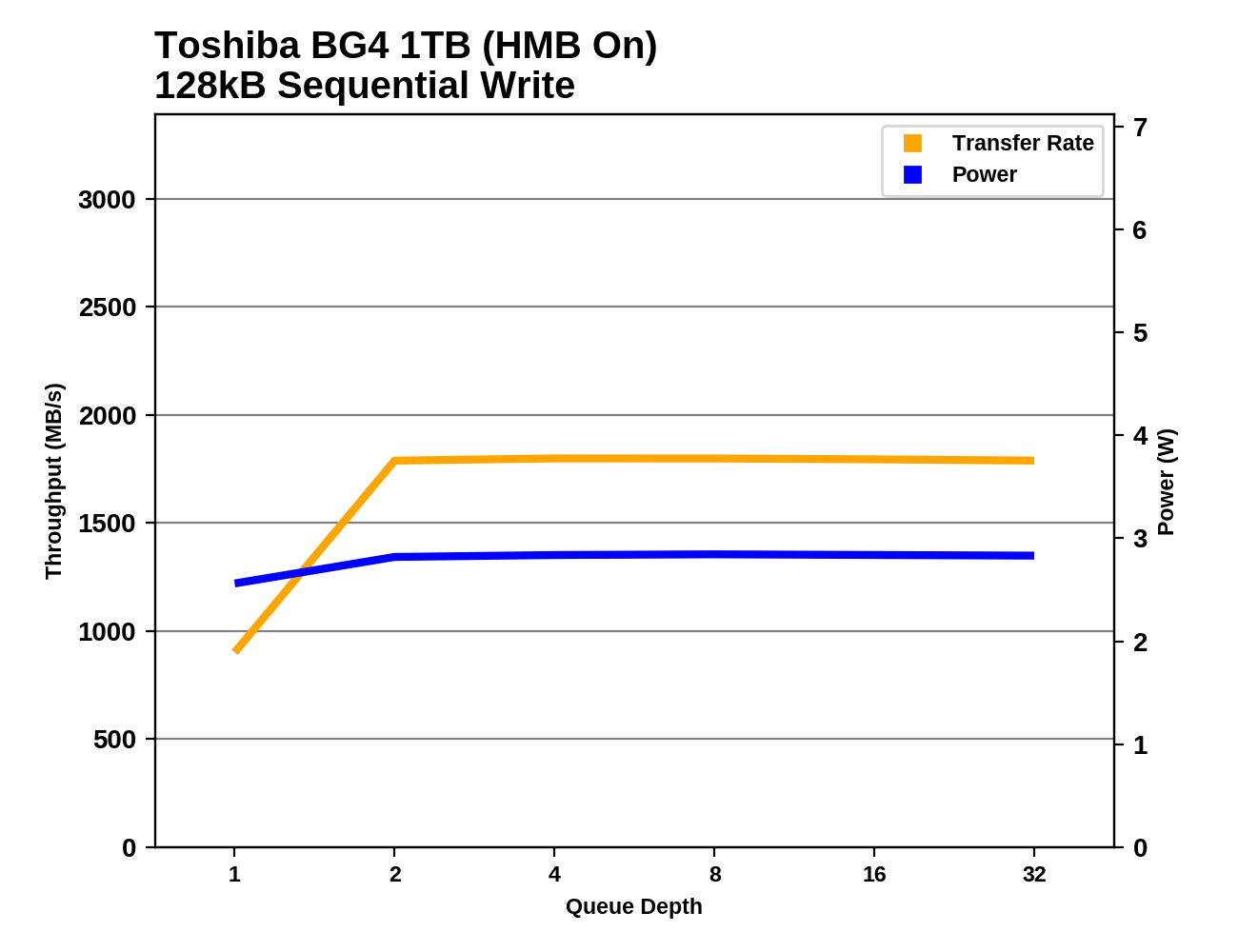The Toshiba/Kioxia BG4 1TB SSD Review: A Look At Your Next Laptop's SSD
by Billy Tallis on October 18, 2019 11:30 AM ESTSequential Read Performance
Our first test of sequential read performance uses short bursts of 128MB, issued as 128kB operations with no queuing. The test averages performance across eight bursts for a total of 1GB of data transferred from a drive containing 16GB of data. Between each burst the drive is given enough idle time to keep the overall duty cycle at 20%.

The burst sequential read speed of the Toshiba/Kioxia BG4 is about 1GB/s: way below par for high-end NVMe SSDs, but fine for an entry-level drive. It's not too far behind Toshiba's own XG6 high-end drive, which turns in a fairly disappointing score on this test.
Our test of sustained sequential reads uses queue depths from 1 to 32, with the performance and power scores computed as the average of QD1, QD2 and QD4. Each queue depth is tested for up to one minute or 32GB transferred, from a drive containing 64GB of data. This test is run twice: once with the drive prepared by sequentially writing the test data, and again after the random write test has mixed things up, causing fragmentation inside the SSD that isn't visible to the OS. These two scores represent the two extremes of how the drive would perform under real-world usage, where wear leveling and modifications to some existing data will create some internal fragmentation that degrades performance, but usually not to the extent shown here.

On the longer sequential read test that brings in some higher queue depths, the BG4 maintains decent performance even while some high-end drives fall down to its level. The BG4's performance reading back data that wasn't written sequentially is particularly good, and at least a bit faster than most high-end NVMe drives can manage.
 |
|||||||||
| Power Efficiency in MB/s/W | Average Power in W | ||||||||
The Toshiba BG4 uses significantly more power during the sequential read test than the older BG3-based RC100, but the performance improvements make that power well-spent. The BG4's power efficiency scores are excellent and beat most high-end NVMe drives.
 |
|||||||||
With HMB on, the BG4's sequential read speed tops out at QD4 or higher and is quite steady. Without HMB, it scales more gradually and ultimately is slightly slower at high queue depths.
The BG4 certainly isn't the fastest SSD on this test with a top sequential read speed a bit above 2GB/s, but for the speeds it does provide the BG4 is one of the most power-efficient drives we have ever tested.
Sequential Write Performance
Our test of sequential write burst performance is structured identically to the sequential read burst performance test save for the direction of the data transfer. Each burst writes 128MB as 128kB operations issued at QD1, for a total of 1GB of data written to a drive containing 16GB of data.

HMB didn't matter much for the burst sequential read test, but for the burst sequential write test it is very helpful, bringing the BG4's performance almost up to the level of most high-end NVMe SSDs.
Our test of sustained sequential writes is structured identically to our sustained sequential read test, save for the direction of the data transfers. Queue depths range from 1 to 32 and each queue depth is tested for up to one minute or 32GB, followed by up to one minute of idle time for the drive to cool off and perform garbage collection. The test is confined to a 64GB span of the drive.

On the longer sequential write test, the BG4 with HMB still manages to be trailing close behind the high-end NVMe drives, and far ahead of most of the other entry-level NVMe competition. With HMB off the BG4 is much slower, but still acceptably fast for an entry-level drive.
 |
|||||||||
| Power Efficiency in MB/s/W | Average Power in W | ||||||||
The BG4 doesn't have the lowest power consumption on the sequential write test, but it does set the record for power efficiency. Even with HMB off the performance remains high enough to give the BG4 a competitive efficiency score.
 |
|||||||||
The BG4 hits full sequential write speed with a queue depth of two or higher, and the performance is very steady after that with no sign of the SLC cache running out. Without HMB, it is limited to about 1GB/s, significantly slower than even the Intel 660p QLC SSD.
At QD2 and higher, the BG4 is one of the most efficient drives we have tested: anything with better sequential write performance is clearly drawing more power, and anything with significantly lower power consumption is also significantly slower.












31 Comments
View All Comments
cschlise - Thursday, October 31, 2019 - link
Bought a Dell Inspiron 15 with an AMD processor recently. Dell claimed the laptop was "fixed form factor, but after removing some screws and gently prying the thing open, a wealth of upgrade options were presented. This system had one of the 2230's installed ... sized at 256GB. The board had space for a full 2280 as well as another 2.5mm drive. I installed a 512GB 2280 NVMe and 1GB 2.5mm SSD, and doubled the RAM ... for a fraction of the price Dell would have sold it to me in more expensive configurations.Bottom line ... if manufacturers are putting 2230's in consumer laptops, they aren't doing the consumer any favors ... also, if you're buying a "fixed form factor" laptop to save a few $$$, with some careful and steady hands, you'll likely find you can upgrade the sucker significantly.